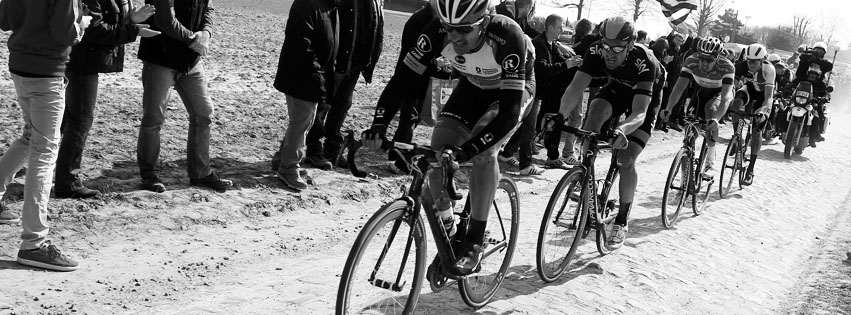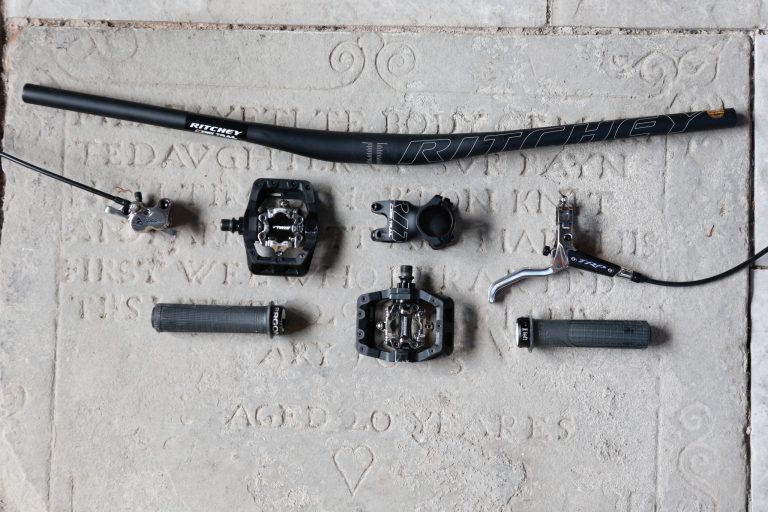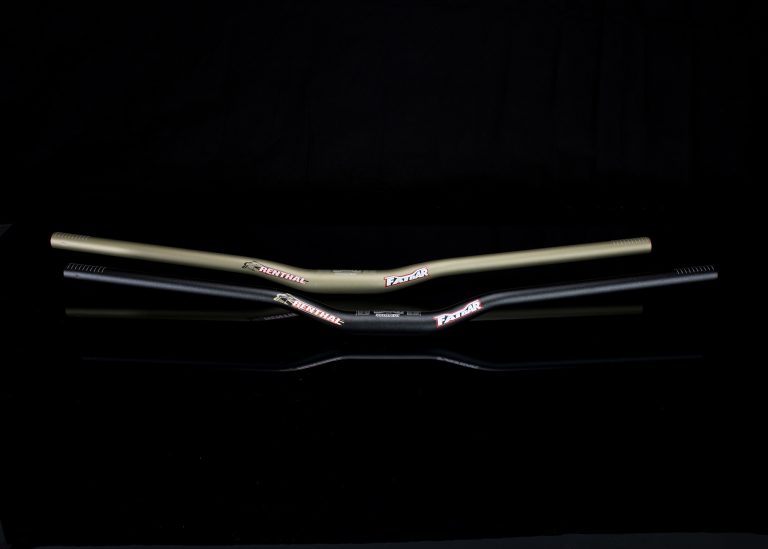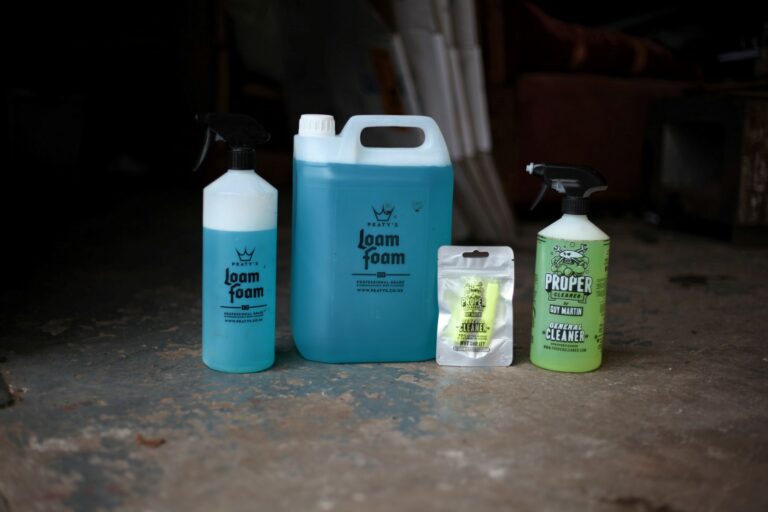
Changes upon the existing design include beefier tubes, a built in stone deflector on the downtube, built in fork bumpers and a specifically tuned rear shock as standard…
From DIRT ISSUE 105 – November 2010
Words by James McKnight. Photos by Sterling Lorence.
I think it is safe to say that the Session was an instant success on its release to the public, and for good reason. Lightweight, defined shaping and clearly a lot of thought put into the fundamental workings – in my opinion a bike that has seriously helped pick up the sport of downhill and re–kindle interest in the evolution of mountain bike technology.
 The week leading up to Interbike 2010 included Trek’s launch of their 2011 Session 88 downhill bike, not an entirely new design, but rather an updated version of the original. Take an already good product and make it better, that is what Trek have done here. It takes a certain amount of modesty to be able to admit that your product can be improved upon, and thankfully Trek aren’t lacking in that department. Yes they are a big ‘corporation’, but behind the scenes, as I found at the recent press launch, there is also a very dedicated and passionate team working on the bikes.
The week leading up to Interbike 2010 included Trek’s launch of their 2011 Session 88 downhill bike, not an entirely new design, but rather an updated version of the original. Take an already good product and make it better, that is what Trek have done here. It takes a certain amount of modesty to be able to admit that your product can be improved upon, and thankfully Trek aren’t lacking in that department. Yes they are a big ‘corporation’, but behind the scenes, as I found at the recent press launch, there is also a very dedicated and passionate team working on the bikes.
THE BIKE
Changes upon the existing design include beefier tubes, a built in stone deflector on the downtube, built in fork bumpers and a specifically tuned rear shock as standard. All small tweaks, you may say, but I think that Trek have got the right idea here. What we can now see is an evolving product that is being constantly worked on by a team of both riders and engineers (and riding engineers for that matter), and with an already successful World Cup team also on the case we can only expect the bike to get better with time.
SUSPENSION
I glanced over the improvements in the previous paragraph, but let me go into the feature that Trek seemed most happy with, and which should improve the bike the most; the rear shock. Look into any ‘serious’ sports (motorsports), and any big team when setting up a bike/car etc will tell  you how important the shock is to the performance of the vehicle. Have a good chassis to start with, which Trek certainly do, and then build on the grip, shock absorption and ride character using the suspension.
you how important the shock is to the performance of the vehicle. Have a good chassis to start with, which Trek certainly do, and then build on the grip, shock absorption and ride character using the suspension.
Trek’s mountain bike team, Trek World Racing, provided the information the factory needed on how to improve on the suspension action. What we now have is a shock absorber that works efficiently and effectively throughout the stroke, particularly pushing out any sort of ‘dead spot’ in the mid stroke.
THE RIDE
Day 1 of the camp in Utah and I was left seriously ‘jaded’ (a concoction of jet lag and line dancing in Vegas), and to be honest, probably not on my best riding form. What I most certainly did not need was a bike that was going to do anything too surprising. Fortunately, I could jump on the Session and within a handful of runs I felt absolutely at home on the bike; turns were good, nothing unexpected on the jumps, and the shock really does work well. Everything just seems to fit in place – the evidence of a bike that has been well tried and tested and clearly had a lot of rider input. I would certainly put this in a list of three if I was considering a downhill specific bike to purchase.
NEGATIVES
My only negative note is the sizing: I was happy to see that four sizes are on offer, I think this should be a minimum for any bike company, but then found the size Large to be just right for me. At 5 foot 10ish, I wouldn’t put myself as a ‘Large’ person – more average (‘Medium’ in bike speak). Just a small niggle but to be considered if you are thinking of buying one.
I went to the press camp with the fear that I would be brainwashed and come away a Trek robot, but I was pleasantly surprised by the laid–back attitude and passionate focus of every Trek employee on hand, and definitely won over by the easy ride of the Session 88.
 BRIAN HEAD
BRIAN HEAD
So the flipside of the Trek press camp was the riding element. The focus of this camp was clearly to show off the new and improved Session, but from what I could gather the Trek crew were also eager just to ride bikes and have a good time.
After several presentations and a ‘warm welcome’ in Vegas (a welcome that only Vegas could produce), we jumped in a typically American bus – the sort that is so impractically large you can’t quite understand what real function it has in the world – trundled out of the City of Sin and headed north east toward the small resort of Brian Head, Utah.
Brian Head is one of those great out of season towns that only mountain biking could take you to, all but deserted yet strangely homely and providing all that a bike rider could ever wish for. Views stretching further than I have ever seen, an incredible mix of colours – reds, greens, yellows, and a lone chairlift making its way to a summit somewhere above town.
Trails were rocky, dusty and punishing, so too the thin air (the town sits at nearly 3,000 metres), and late summer sun of Utah. Having hosted many a race, including a round of the NORBA series back in the day, the hill here is littered with deceased trails, remnants of a slope that has quietly fostered the sport since its early days. Now there are several permanent tracks that we had the pleasure of tearing down for two days – a full–bore downhill track, a mellow but fun ride around the mountain, and also an area with a ‘freestyle element’, as the signs explained.
Afternoons were taken care of by the Mountain Express Shuttle, who packed us into another great American vehicle, this ‘van’ having space for 14 with bikes, and off–roaded us up and into the back end of the area unreachable by chairlift. Dark Hollow was my favourite shuttle and a trail that is everything that I had imagined of American riding; a long flowing succession of rocks, creek crossings and mellow turns, joined by foot wide smooth–as–you–like single track and ending in spectacular scenery a thousand metres below. Awesome.
Not a huge range of trails, but if you happened to be passing (as you do) there’s certainly enough to keep you going for a couple of days. Another interesting note being that the town is German founded, this in itself not particularly enthralling, but time a visit right and you may find yourself in the midst of Oktoberfest, in Utah, USA. Strange.

 BRIAN HEAD
BRIAN HEAD




